Description
While Botticelli adopted a more expressive composition in his Saint Augustine (inspired by Andrea del Castagno's works), Ghirlandaio created a more serene and conventional figure, concentrating instead on the still life of the objects exposed on the writing desk and the shelves behind Jerome. In this, he was perhaps inspired by northern European models, such as Jan van Eyck's Saint Jerome in His Study which was in the collections of Lorenzo de' Medici.
Jerome is portrayed with his head resting on one hand, while writing with the other. This was the same posture chosen by Jan van Eyck. The open books and the cartouches, with Greek and Hebrew letters, correspond to his activity as translator of the Bible. On the writing desk is the date (MCCCCLXXX), as well as a sealed letter, glasses, two inkwells (with drops of ink near them), scissors and a candle holder. The desk is covered by an oriental carpet, a luxurious object often depicted by Ghirlandaio, and perhaps also inspired by Netherlandish painters. The objects on the shelves include a cardinal hat, two pharmacist vases, a cylindrical case, a necklace, a purse, some fruit, two transparent glass bottles and an hourglass.
The light comes from the upper right corner, producing a well defined shadow of the saint on the drapery behind him; but also from the foreground, illuminating the objects on the desk.

Alessandro di Mariano di Vanni Filipepi, better known as Sandro Botticelli or simply Botticelli, was an Italian painter of the Early Renaissance. Botticelli's posthumous reputation suffered until the late 19th century, when he was rediscovered by the Pre-Raphaelites who stimulated a reappraisal of his work. Since then, his paintings have been seen to represent the linear grace of late Italian Gothic and some Early Renaissance painting, even though they date from the latter half of the Italian Renaissance period.

Domenico di Tommaso Curradi di Doffo Bigordi, professionally known as Domenico Ghirlandaio, was an Italian Renaissance painter born in Florence. Ghirlandaio was part of the so-called "third generation" of the Florentine Renaissance, along with Verrocchio, the Pollaiolo brothers and Sandro Botticelli. Ghirlandaio led a large and efficient workshop that included his brothers Davide Ghirlandaio and Benedetto Ghirlandaio, his brother-in-law Bastiano Mainardi from San Gimignano, and later his son Ridolfo Ghirlandaio. Many apprentices passed through Ghirlandaio's workshop, including the famous Michelangelo. His particular talent lay in his ability to posit depictions of contemporary life and portraits of contemporary people within the context of religious narratives, bringing him great popularity and many large commissions.

Filippino Lippi was an Italian painter working in Florence, Italy during the later years of the Early Renaissance and first few years of the High Renaissance.

Renaissance art is the painting, sculpture, and decorative arts of the period of European history known as the Renaissance, which emerged as a distinct style in Italy in about AD 1400, in parallel with developments which occurred in philosophy, literature, music, science, and technology. Renaissance art took as its foundation the art of Classical antiquity, perceived as the noblest of ancient traditions, but transformed that tradition by absorbing recent developments in the art of Northern Europe and by applying contemporary scientific knowledge. Along with Renaissance humanist philosophy, it spread throughout Europe, affecting both artists and their patrons with the development of new techniques and new artistic sensibilities. For art historians, Renaissance art marks the transition of Europe from the medieval period to the Early Modern age.

Pinturicchio, or Pintoricchio, also known as Benetto di Biagio or Sordicchio, was an Italian painter during the Renaissance. He acquired his nickname because of his small stature and he used it to sign some of his artworks that were created during the fifteenth and sixteenth centuries.
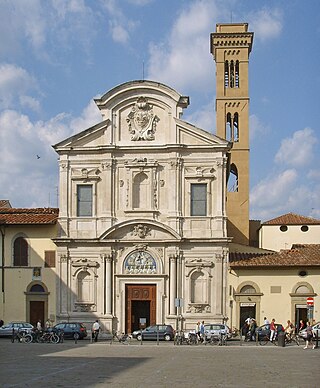
The chiesa di San Salvatore di Ognissanti, or more simply chiesa di Ognissanti, is a Franciscan church located on the piazza of the same name in central Florence, region of Tuscany, Italy. Founded by the lay order of the Umiliati, the church was dedicated to all the saints and martyrs, known and unknown.

The Sassetti Chapel is a chapel in the basilica of Santa Trinita in Florence, Italy. It is especially notable for its frescoes of the Stories of St. Francis, considered Domenico Ghirlandaio's masterwork.
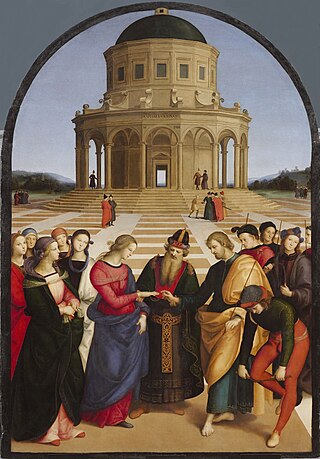
Italian Renaissance painting is the painting of the period beginning in the late 13th century and flourishing from the early 15th to late 16th centuries, occurring in the Italian Peninsula, which was at that time divided into many political states, some independent but others controlled by external powers. The painters of Renaissance Italy, although often attached to particular courts and with loyalties to particular towns, nonetheless wandered the length and breadth of Italy, often occupying a diplomatic status and disseminating artistic and philosophical ideas.
The decade of the 1480s in art involved some significant events.
The decade of the 1440s in art involved some significant events.

Saint Augustine in His Study is a fresco painting of Augustine of Hippo executed in 1480 by the Italian Renaissance master Sandro Botticelli. It is in the church of Ognissanti in Florence.
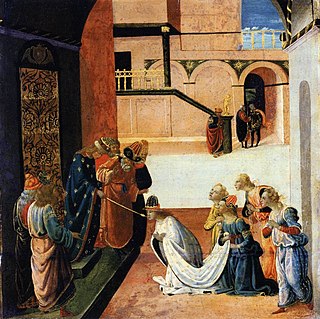
Jacopo del Sellaio (1441/42–1493), was an Italian painter of the early Renaissance, active in his native Florence. His real name was Jacopo di Arcangelo. He worked in an eclectic style based on those of Botticelli, Filippino Lippi, and Domenico Ghirlandaio. The nickname Sellaio derives from the profession of his father, a saddle maker.
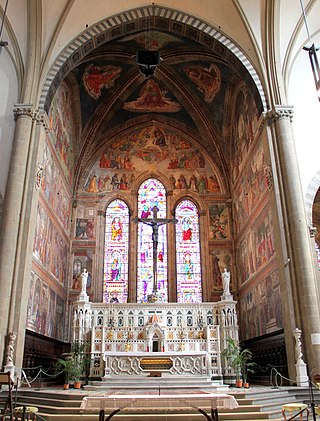
The Tornabuoni Chapel is the main chapel in the church of Santa Maria Novella, Florence, Italy. It is famous for the extensive and well-preserved fresco cycle on its walls, one of the most complete in the city, which was created by Domenico Ghirlandaio and his workshop between 1485 and 1490.
Saint Jerome in His Study may refer to the following artworks depicting Saint Jerome:

Bastiano di Bartolo Mainardi (1466–1513) was an Italian painter of the Early Renaissance. He was born in San Gimignano and was active there and in Florence.

The Bufalini Chapel is a side chapel of the church of Santa Maria in Aracoeli, Rome, Italy. The first chapel on the right after the entrance, it houses a cycle of frescoes executed c. 1484-1486 by Pinturicchio depicting the life of the Franciscan friar St. Bernardino of Siena, sainted in 1450.

Moses Leaving for Egypt is a fresco by the Italian Renaissance painter Pietro Perugino and his workshop, executed around 1482 and located in the Sistine Chapel, Rome. It depicts a journey by the prophet Moses.

The Baptism of Christ is a fresco by the Italian Renaissance painter Pietro Perugino and his workshop, executed around 1482 and located in the Sistine Chapel, Rome.

The Annunciation has been one of the most frequent subjects of Christian art. Depictions of the Annunciation go back to early Christianity, with the Priscilla catacomb in Rome including the oldest known fresco of the Annunciation, dating to the 4th century.
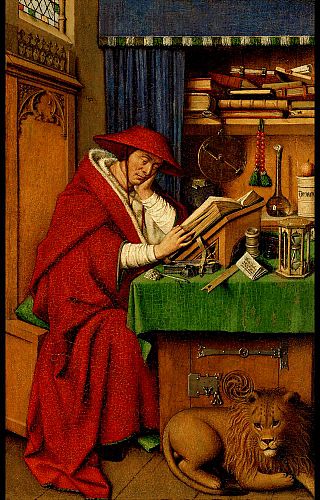
Saint Jerome in His Study is an oil painting on panel no larger than an oversized postcard attributed to the workshop of the early Netherlandish painter Jan van Eyck and is currently in the collection of the Detroit Institute of Arts. Purchased in 1925 by museum director Dr. W.R. Valentiner, the small Flemish painting at that time was attributed to Petrus Christus. The painting depicts St. Jerome, the 4th-century translator of the Bible, reading in his study, wearing a cardinal's dress and hat. He is surrounded by objects exemplyfying late medieval intellectual life and accompanied by the pet lion that is his common attribute.

















